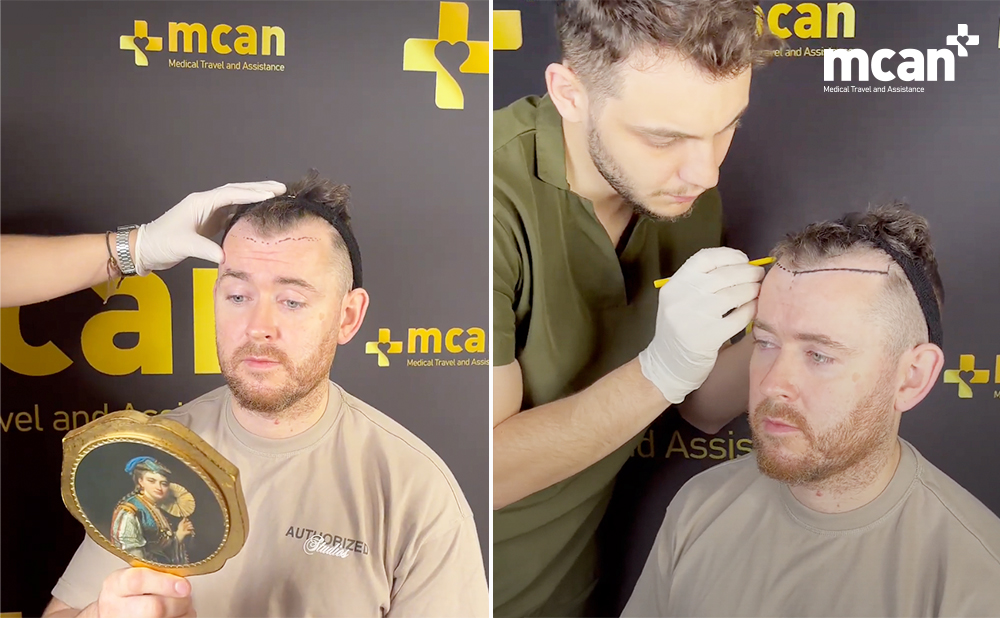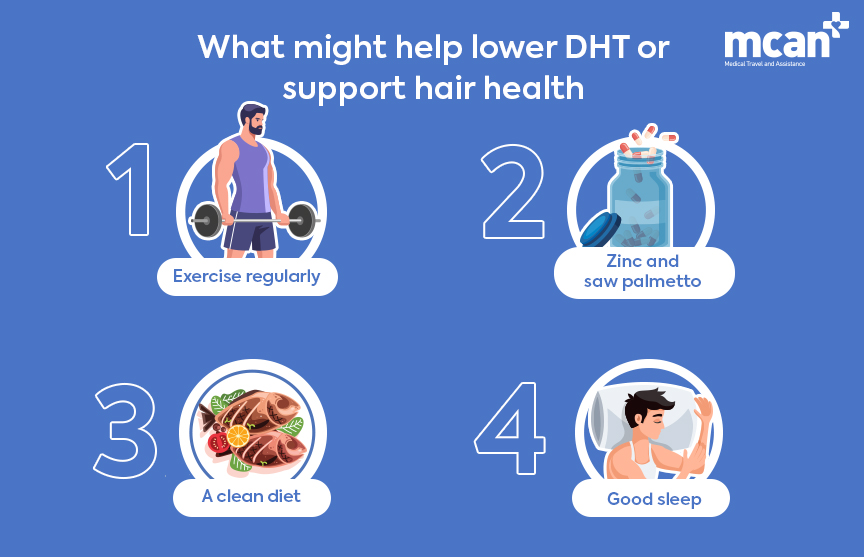
You’ve invested in your hair transplant. The procedure is done, the healing has started, and you’re eyeing the small bottle of finasteride in your aftercare pack. The question pops up, as it does for so many others: Is finasteride really something I need to take after hair transplant?
This isn’t a passing thought. It’s a genuine concern shared by thousands of men. You’ve made a big decision for your appearance and confidence and naturally you want to protect that. But finasteride isn’t a mild conditioner. It’s a hormone-influencing medication with plenty of mixed reviews online.
While your transplanted hairs are here to stay, the rest of your natural hair remains vulnerable to DHT-related thinning. Without added support, that can lead to uneven results over time.
In this article, we’ll break down what finasteride actually does, when it’s worth considering after your hair transplant, who benefits most, and what alternatives exist if the pill isn’t for you.
What Is Finasteride And What Does It Really Do?

Finasteride is not a new player in the hair loss game. It’s been prescribed for decades, and it’s one of the only FDA-approved oral medications for male pattern baldness. But understanding what it does, and whether it’s for you, is crucial.
So what exactly does it do?
- It blocks an enzyme called 5-alpha reductase.
- That enzyme is responsible for converting testosterone into DHT (dihydrotestosterone).
- DHT is the hormone that shrinks hair follicles in men with genetic hair loss.
Finasteride doesn’t “grow hair” in the way you might think. What it actually does is slow down the process of hair miniaturization caused by DHT. For many men, it also helps thicken existing hair by reducing shedding and improving follicle health.
Quick Finasteride Facts Table
| Feature | Finasteride Role |
|---|---|
| FDA Approved | Yes, for androgenetic alopecia |
| How It Works | Lowers DHT levels |
| Primary Benefit | Slows hair loss, preserves native hair |
| Form | Oral tablet (usually 1 mg daily) |
| Common Brand Name | Propecia |
| Time to See Results | 3 to 6 months |
Real Talk About Finasteride
Think of finasteride like insurance. It won’t rebuild your house after the storm (that’s your transplant), but it will help you keep the parts that are still standing. For men in their 20s and 30s with ongoing hair loss, that’s a big deal.
Up next, we’ll look at finasteride after a hair transplant specifically.
Is it a safety net, or just extra baggage?
Finasteride After Hair Transplant: A Safety Net or a Crutch?
Here’s where most patients hit a fork in the road. The transplant is done, the recovery is going smoothly, but the question still lingers: “Should I really be taking finasteride now?”
You’ll hear two camps: one swears by it, the other wants nothing to do with it. The truth? It depends on your situation.
Finasteride is a safety net if…
- You’re under 40 and still experiencing active hair loss.
- Your family history suggests continued thinning in the crown or mid-scalp.
- You want to maintain density around the transplanted area.
- You had a high Norwood stage (advanced hair loss) and only a limited number of grafts could be used.
But it may feel like a crutch if…
- You’ve already stabilized your hair loss for years.
- You’re older and hair loss progression has clearly plateaued.
- You experienced side effects in the past and are wary of long-term medication.
In simple terms: finasteride doesn’t help the transplanted hairs. Those grafts are resistant to DHT. What it does help is the hair you didn’t transplant. This is where finasteride earns its keep.
For patients planning their long-term strategy, check out Hair Transplant Success: The Key Elements Behind a Great Result as it dives deeper into how after-care choices shape lasting outcomes.

When to Start Finasteride After a Hair Transplant
Timing can make or break your experience with finasteride. Some patients start too soon and get discouraged by temporary side effects or “shedding” phases. Others wait too long and notice new thinning just as their transplanted hair is settling in.
So, when should you begin?
Typical Recommendations (from experienced surgeons)
- Not immediately after surgery. Most doctors suggest waiting at least 2 to 4 weeks after your hair transplant.
- This allows your body to focus on healing the recipient and donor areas without being impacted by changes in hormone levels.
- Starting finasteride before your transplant can also be beneficial, especially if you’re already dealing with aggressive hair loss.
Why delay it slightly?
- Finasteride affects hair in growth cycles, not instantly.
- The post-transplant period includes a natural shedding phase, called shock loss, and you don’t want to confuse this with finasteride side effects.
- Giving your scalp a little breathing room can help you observe and assess changes more clearly.
A Sample Timeline for Finasteride After Hair Transplant
| Timeline | What Happens | Should You Start Finasteride? |
|---|---|---|
| 0–2 weeks post-op | Healing, crusting, redness | No – let your scalp recover |
| 2–4 weeks | Shedding phase begins | Maybe – ask your doctor |
| 1 month onward | Shock loss continues, native hair vulnerable | Yes – if hair loss is active |
| 3–6 months | Transplanted hair begins regrowth | Continued use encouraged |
Want a clearer picture of how your scalp heals over time? Read Hair Transplant Timeline: A Guide to Hair Transplant Recovery & Growth Chart for a full recovery roadmap.
What If You Don’t Finasteride After Hair Transplant?
Skipping finasteride after a hair transplant isn’t the end of the world. But it is a decision that comes with trade-offs, especially if your hair loss isn’t progressing.
Here’s what you might expect
- Your transplanted hair will remain intact. It’s immune to DHT.
- The hair you didn’t transplant? Still vulnerable.
- Over time, this native hair may continue thinning, especially at the crown and temples.
- This can lead to a patchy look, requiring touch-up surgeries down the road.
Common scenarios without finasteride
- You get great results in the first year. Then by year two, you notice gaps; not in the grafts, but around them.
- Your hairline stays sharp, but the density behind it starts to fade.
- The “island effect” where the transplanted zone looks dense, but surrounding areas look hollow and becomes noticeable.
Why does this happen?
Because hair loss isn’t static. A transplant gives you back lost hair, but it doesn’t stop the underlying condition. That’s where finasteride plays a protective role.
Who’s at higher risk without it?
- Men in their 20s and early 30s
- Those with strong family history of balding
- Patients who only treated frontal areas and left crown untouched
Some patients do just fine without it:
- If your hair loss has already plateaued
- If your donor supply allowed for full coverage
- If you’re open to future procedures
Bottom line: Not taking finasteride won’t undo your transplant, but it might shorten how long your overall look stays balanced. If you’re not using finasteride, you’ll need to be extra attentive to early signs of thinning elsewhere.
Side Effects: Understanding the Trade-Offs
Let’s be upfront: Finasteride works. But it’s also the reason many patients hesitate after their transplant. The word “side effects” often turns this decision into a psychological tug-of-war. So let’s look at it clearly, minus the fear or hype.
Common Side Effects (affecting a small percentage of users)
- Reduced libido
- Erectile dysfunction
- Decreased semen volume
- Brain fog or mood changes (less common)
These side effects usually appear within the first few weeks if they’re going to show up at all. Most users don’t experience them. For those who do, many report that symptoms reverse after stopping the medication.
Facts vs. Fear: What the Data Says
| Concern | Reality Check |
|---|---|
| Long-term sexual dysfunction | Extremely rare and often overstated |
| Fertility impact | Minimal in low-dose (1mg) use |
| Mental health changes | No consistent evidence, but consult if mood shifts |
How to Minimize Risk
- Start slow: some doctors suggest taking it every other day to gauge tolerance.
- Stay hydrated and eat well and basic.
- Talk with your doctor early if you feel “off.” Adjustments can be made.
The DHT Dilemma: Can Lifestyle Changes Compete?
There’s a growing crowd of men who want the benefits of finasteride but without the pill. Their reasoning? If DHT is the problem, maybe they can tackle it naturally through smarter living. It’s a valid instinct. But can lifestyle alone really compete?
Let’s look at what’s possible and what’s wishful thinking.
What might help lower DHT or support hair health

- Exercise regularly: Boosts circulation, reduces stress-induced hair loss.
- Zinc and saw palmetto: These are often mentioned in natural DHT-blocking supplements.
- A clean diet: Processed sugar and trans fats may increase inflammation and worsen hair shedding.
- Good sleep: Supports hormone balance overall.
But here’s the limit:
- No natural method has shown the same consistency or clinical results as finasteride when it comes to reducing DHT at the follicle level.
- Lifestyle changes are great support strategies, not primary treatments.
Think of it this way:
- Finasteride is the fire extinguisher.
- Lifestyle is the smoke detector, the fresh air, and the habit of not playing with matches indoors.
Alternatives to Finasteride After Hair Transplant
Not every patient wants to commit to daily finasteride and that’s okay. Whether it’s due to side effects, personal preference, or long-term concerns, there are other tools in the hair maintenance toolkit. Some are topical, others are procedural, but they all serve one purpose: protecting your non-transplanted hair.
And for a guide on how nutrition supports hair regrowth and overall scalp health, take a look at Essential Nutrition Guide: Hair Transplant Surgery as it covers vitamins, diet, and habits that matter.
Let’s break down your main options:
1. Topical Minoxidil (e.g. Rogaine)
- How it works: Increases blood flow to the scalp and prolongs the anagen (growth) phase of the hair cycle.
- Use it for: Strengthening thinning hair and slowing down further loss.
- Pros: No hormonal impact, available over-the-counter.
- Cons: Requires daily application, and results fade if you stop.
2. Topical Finasteride
- How it works: Delivers finasteride directly to the scalp with less systemic absorption.
- Use it for: Men who want DHT control without full-body effects.
- Pros: Lower risk of side effects than oral version.
- Cons: Not as widely studied yet. Can be expensive.
3. PRP (Platelet-Rich Plasma) Therapy
- How it works: Your blood is processed to extract growth factors and injected into your scalp.
- Use it for: Stimulating weaker follicles and improving hair thickness.
- Pros: Drug-free, uses your own biology.
- Cons: Needs multiple sessions and upkeep. Not cheap.
4. Microneedling
- How it works: Creates micro-injuries that stimulate collagen and increase absorption of serums or minoxidil.
- Use it for: Improving scalp health and boosting product efficacy.
- Pros: At-home kits available. Minimal cost.
- Cons: Can be irritating if not done correctly.
Real-Life Combo Strategy
Many patients combine topical minoxidil + PRP or microneedling + finasteride for layered support. You’re not limited to a single path. What matters is that your post-transplant plan supports the entire scalp.
For a comprehensive overview of topical options, shampoos, serums, and more, see Everything You Should Know About DHT Blockers, which breaks down over-the-counter and prescription-level treatments.
Finasteride After Hair Transplant: Informed Choices for Lasting Results

Protecting your new hair doesn’t stop at the surgery. It extends into how you maintain the health of the hair you didn’t transplant. Whether you choose to take finasteride or explore alternative solutions, your post-transplant strategy plays a vital role in the long-term success of your results.
At MCAN Health, aftercare is not an afterthought. Our approach includes transparent guidance on medications like finasteride, alternative options, and a personalised recovery plan tailored to your needs and goals.
If you’re planning a hair transplant in Turkey, MCAN Health offers not just skilled surgeons, but ongoing support that helps you protect and preserve your hair.
 Best Age for Hair Transplant: When Should You Consider the Procedure?
Best Age for Hair Transplant: When Should You Consider the Procedure?  DHI vs. FUE: Hair Transplant Procedures Compared
DHI vs. FUE: Hair Transplant Procedures Compared  How to Stop Receding Hairline: Causes & Treatment
How to Stop Receding Hairline: Causes & Treatment